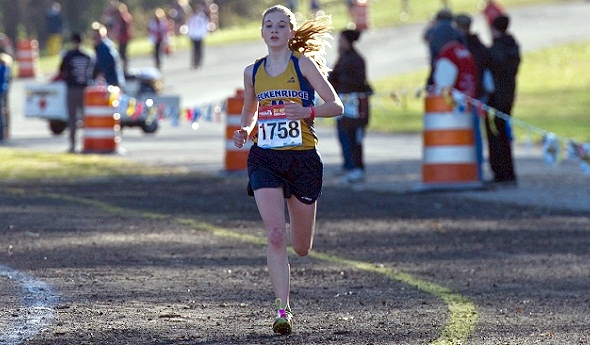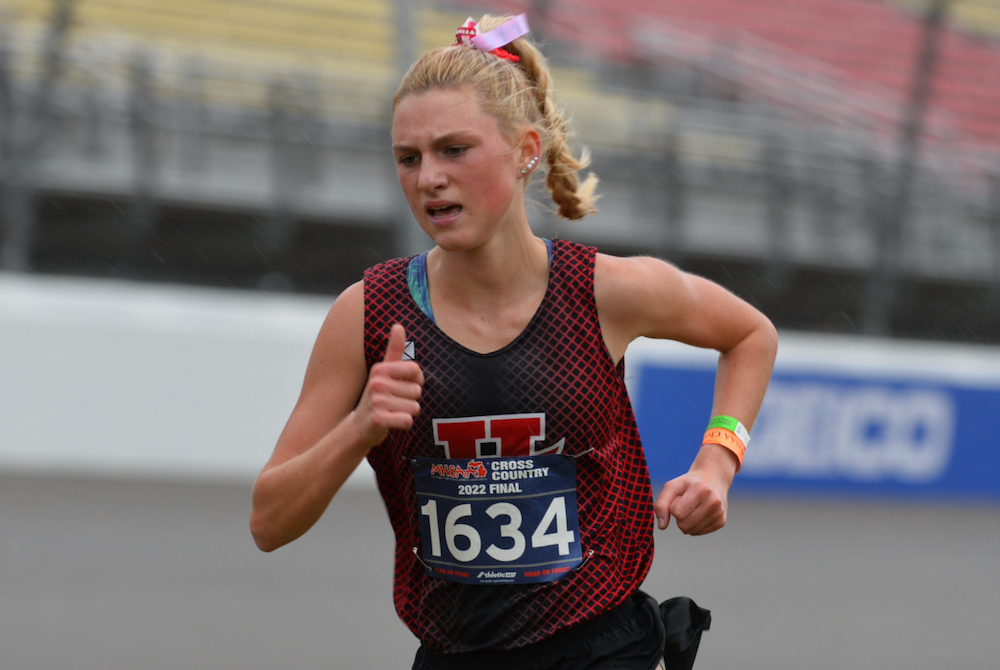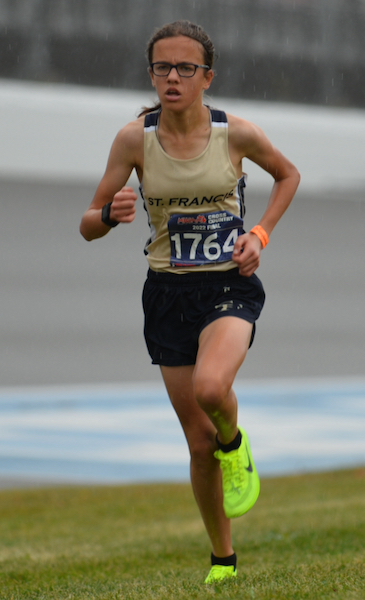
Finals Preview: Running for Another First
October 31, 2012
By Geoff Kimmerly
Second Half editor
Three of last season's girls cross country team champions are again ranked among the top three in their respective divisions heading into Saturday's MHSAA Finals at Michigan International Speedway. Three of last season's four individual winners also are back for another title try.
Just pencil them in for first again, right? Cross country isn't that easy to forecast.
West Bloomfield's Erin Finn, Grand Rapids Christian's Julia Bos and Breckenridge's Kirsten Olling all are back to defend their 2011 MHSAA championships. But they'll face a number of challengers, most they've run against but a few newer faces as well. Same for most of the favored teams, which have likely crossed paths at least once this fall. But often that doesn't matter when they're coming down the MIS home stretch.
Here's a look at some of the teams and individuals expected arrive on the medal stand by the time Saturday's races are done. Click for Saturday's race schedule and links to all qualifiers.
DIVISION 1
Reigning champion: Grosse Pointe South
2011 runner-up: Saline
2012 top three: 1. Birmingham Seaholm, 2. Saline, 3. Grosse Pointe South
Seaholm moved ahead of Grosse Pointe South about two weeks ago as the favorite in Division 1, with the top four from last season’s fourth-place Finals finisher back and led by senior Aubrey Wilberding – who crossed 11th in 2011. Saline finished second last season on the strength of four placers among the top 33, and five of the team’s top six from that day are back. But don’t be shocked to see a repeat from the Blue Devils, with all five of last season’s placers back in the lineup. They took five of the top nine at the Regional.
Individuals: Seven of last season’s top 10 will be back at MIS, with West Bloomfield senior Finn and Grosse Pointe South senior Hannah Meier regarded nationally, the latter a bit more from her track prowess. Finn won the title last season in 17:22.6, and Meier was third in 17:24.1.
DIVISION 2
Reigning champion: East Grand Rapids
2011 runner-up: Cedar Springs
2012 top three: 1. Ada Forest Hills Eastern, 2. Spring Lake, 3. East Grand Rapids
Forest Hills Eastern is looking to make a giant jump from last season’s 14th-place finish, and is paced by Regional champion and senior Clara Cullen – with junior Mary Kostielney taking seventh and freshman Lauren Allard 10th last week. Cullen finished 18th individually at last season's Final. Spring Lake didn’t even make the Final as a team last season, but now-senior Brittany Beeler finished 13th individually and was one of three from her team among the top 18 at a strong Regional last weekend. East Grand Rapids graduated its top two from last season’s championship team, but got a sixth-place Regional finish from sophomore Kaela Theut. Grand Rapids Christian, led by individual reigning champion Bos, beat both Spring Lake and East Grand Rapids at the Regional and is ranked No. 4.
Individuals: Bos, a senior, won the Regional in 17:18.21 and edged Cedar Springs’ Kenzie Weiler by 11 seconds in last season’s Final; Weiler is back this fall as a sophomore. Three more of the 2011 top 10 also are back, with Remus Chippewa Hills senior Megan O’Neil and Cedar Springs senior Katie Weiler following Kenzie for the top three spots at their Regional after the latter two finished fifth and sixth, respectively, at last season’s Final.
DIVISION 3
Reigning champion: Benzie Central
2011 runner-up: Kent City
2012 top three: 1. Grandville Calvin Christian, T-2. Benzie Central, T-2. Jackson Lumen Christi
Calvin Christian enters as the favorite on the strength of six of the top seven from last season’s eighth-place finisher. Six of those seven finished among the top 17 at the Regional. Benzie Central placed six of the top 19 at its Regional, and junior Bryce Cutler finished 26th at last season's Final. Lumen Christi finished fourth in 2011 in large part thanks to two freshmen who are now even better sophomores – Aubrey Penn and Caitlin Clark, who are both coming off top-47 Final finishes.
Individuals: Seven of last season’s top 10 also return in this division, headlined by reigning runner-up and senior Raquel Serna of St. Louis and Ida sophomore Ashley Sorge. Serna ran an 18:21.4 at the Regional to beat a groupby 32 seconds that included two more returning top-10 Finals finishers. Sorge also won her Regional, by 28 seconds, in 19:02.3.
DIVISION 4
Reigning champion: Hesperia
2011 runner-up: North Muskegon
2012 top three: 1. Harbor Springs, 2. Bear Lake/Onekama, 3. Beal City
Harbor Springs finished fifth in Division 3 last season and has four of those top six runners back this weekend. Bear Lake/Onekama finished 12th in Division 4 last season with only one senior; the other six runners all are back, including four who were freshmen in 2011. Beal City returns five of its top seven from last season’s 10th-place team, and freshman Hannah Steffke finished third at the Regional.
Individuals: Breckenridge junior Kirsten Olling has won the last two Division 4 Finals and did so last year by nearly 38 seconds. She won her Regional last week by 1:20 with a time of 18 minutes flat. Montabella junior Taylor Smith finished runner-up at that Regional, and might be the second-fastest in the entire Division 4 field after finishing fifth as a sophomore.
PHOTO: Breckenridge's Kirsten Olling rounds the final bend before re-entering the MIS track area during last season's Division 4 Final. (Click to see more from HighSchoolSportsScene.com).

Jazwinski Brings Hart Individual Title as St. Francis Moves to Front of Team Pack
November 5, 2022
BROOKLYN – Cross country races can be won between the ears before runners ever step foot onto the course.
Attitudes were tested as rain began to descend on Michigan International Speedway and the wind picked up just before the start of the MHSAA Lower Peninsula Division 3 girls race late Saturday morning.
Hart sophomore Jessica Jazwinski was loving life as she prepared to race.
“As a distance runner, I really try to love the wind,” she said. “Distance running and cross country is just a tough sport. The wind just adds to it — and the rain, too. It’s super fun.
“I was just thinking these conditions are just gonna feed my great race. This is real cross country. Yeah!”
Jazwinski overcame the elements to run the fifth-fastest Division 3 time ever, winning with a time of 17:36.70. She has two of the top-five times in Division 3 Finals history, having run 17:31.4 to place third last year.
“Today my race plan was just to go out hard and try to hold on to my pace,” she said. “I feel like I tried to race a lot like Steve Prefontaine, just go out and hold on.”
 Lansing Catholic senior Hannah Pricco was second in 18:17.59, Onsted sophomore Emmry Ross was third in 18:20.96 and Hart junior Alyson Ens was fourth in 18:28.52.
Lansing Catholic senior Hannah Pricco was second in 18:17.59, Onsted sophomore Emmry Ross was third in 18:20.96 and Hart junior Alyson Ens was fourth in 18:28.52.
“I love having great teammates to work with and encourage each other,” Jazwinski said. “We really try to encourage each other so much throughout the races. Throughout this year, some races she’s been a minute behind me, some races she’s been five seconds. I don’t want her to ever beat me, so that pushes me so much. I know she’s trying to race me and get up there with me.”
The only downer for Hart was having its string of Division 3 championships end at five with a fourth-place finish. Hart had two runners in the top four, but its No. 3 runner was 68th.
“I would totally trade my individual title for a team title,” Jazwinski said.
Traverse City St. Francis emerged from a close battle to win its first title since 2016 with 134 points. Pewamo-Westphalia was second with 142 and Lansing Catholic third with 165.
Sophomore Betsy Skendzel led St. Francis, placing seventh in 18:48.33. Completing the team score were senior Sophia Rhein in 26th (19:43.27), sophomore Grace Slocum in 33rd (20:07.95), junior Rylee Duffing in 60th (20:44.82) and junior Margot Hagerty in 63rd (20:45.78).
Lansing Catholic had three place in the top 10, but didn’t get another finisher until 103rd.
PHOTOS (Top) Hart’s Jessica Jazwinski pushes toward the finish during Saturday’s LPD3 Final. (Middle) Traverse City St. Francis’ Betsy Skendzel leads the way for the eventual team champion. (Click for more from Dave McCauley/RunMichigan.com.)

